ATLANTA — Currently, 174,000 doses of Moderna's COVID-19 vaccine are arriving in Georgia beginning on Monday and will continue to do so throughout the week, now that the FDA has approved it for emergency use.
According to the Department of Health and Human Services, that allotment is part of the 5.9 million doses of Moderna vaccines being distributed throughout the United States this week. An additional 2 million more doses of Pfizer are also expected Christmas week.
The secretary of Health and Human Services (HHS) said there's a reason more Moderna vaccines are being handed out this week than Pfizer vaccines.
"In part because the Moderna vaccine can be accommodated in more sites including harder to reach and more rural places," said Secretary Alex Azar during a press conference Monday morning.
Last week, many rural hospitals skipped out on Pfizer's vaccine because they did not have the extra-cold freezer availability needed for the doses which have to be kept at minus 70 degrees Celsius. Meanwhile, Moderna's can be kept at minus 20 degrees Celsius.
"Generally the deep freeze environment is more available in cities than it is in rural areas so that makes the Pfizer vaccine a little bit harder to keep in storage or keep at the appropriate temperature in rural areas," said supply chain expert Julie Swann.
Swann, who helped the CDC with the H1N1 response back in 2009, says another difference between both vaccines is also the amount that can be shipped at once.
"The Moderna vaccine has a lower requirement on the minimum shipping size for the shipment -- it's only 100 doses so we're likely to see some of that go to rural areas that may have smaller target populations," she said.
In comparison, there can be anywhere from 1,000 to 5,000 Pfizer vaccine doses in a box.
Rural communities in Georgia, especially in the northeast portion, are in dire need of vaccines.
The map below shows the number of cases in each county per 100,000 people. The dark red counties have had the highest rate of COVID-19 cases in the last two weeks.


Health experts say these areas can be disproportionately affected because typically poverty rates and the number of uninsured residents are higher in rural areas.
Swann says the difference in the distribution of these vaccines, however, shouldn't widen the gap even further.
"The good news is that both vaccines have similar levels of efficacy and similar values for safety; so, I'm not expecting a lot of inequities to result from sending one more to populated areas and one more to rural areas," she explained.

